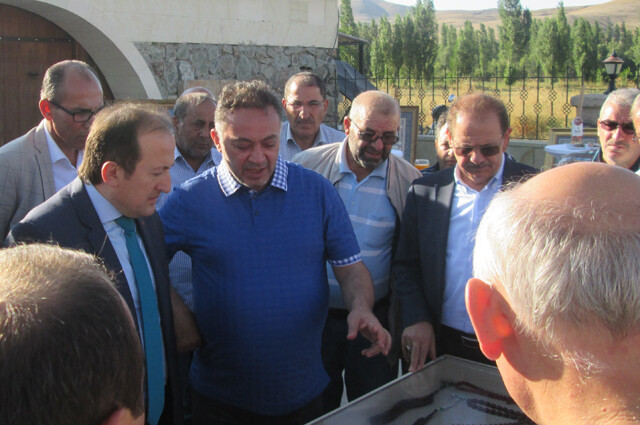The museum that challenges concrete
- 13 September 2020
- Posted by: Muze Yonetimi
- Categories: Basında Biz, Duyurular

https://www.aksam.com.tr/ Saturday/betonlasmaya-head-tutan-muze/haber-1108951
Kenan Yavuz Ethnography Museum, a rare museum in our country and in the world … The museum, which was established to raise awareness against the architectural damage caused by the transformation that started with the phenomenon of modernization and migration, and to keep alive the beauties of the traditional life, which is about to be forgotten, in the minds of the new generations, is a is building a bridge.
Kenan Yavuz Ethnography Museum, established with the concept of a living museum, stands up for the traditions and culture of the region. Located in Bayburt Province, Demirözü District, Beşpınar Village, all the buildings in the museum were built in harmony with the texture and architectural structure of the region in relation to time and space. The museum, whose construction started in 2013 and built on an area of 9 thousand square meters; Village House, Water Mill, Bezir Oil Mill, Amphitheater and Open Air Cinema, Village Square, Dede Korkut Turkish Identity Library, Masjid, Tandoori, Permanent Çinimaçin Exhibition Area, Indoor Exhibition Halls, Open Exhibition Areas, Swing, Bayburt Pigeon Bird House, It consists of Ashane, Gecekondu and Konak sections. Many festivals are organized in the museum where traditions that are about to be forgotten are kept alive. The museum, which allows visitors to get acquainted with the local culture with the slogan “Whoever comes to us, live us”, is experiencing authentic examples of Bayburt folklore.
OWNING OUR PAST IS OUR NECK DEBT
Kenan Yavuz, who set out to create an awareness against the architectural damage caused by the transformation that started with the phenomenon of modernization and migration, and to keep the beauties of the traditional life, which is about to be forgotten, alive in the minds of new generations, explains the purpose of establishing the museum as follows: “To establish the museum in my village, where I was born It is a result of my sense of owning our past. Our aim was to be a small point of resistance to the concrete architectural texture of our villages, the forgotten traditions, the weakening of family ties and the phenomenon of migration from the village to the city. As a result of our work started in 2013, we attained the official museum status in September 2019. ”
There are traces of life in museum buildings
The museum, which was built very different from the classical museology understanding, instead of the modern building where only ethnographic works are exhibited in the relationship of time-space, all of the spaces are ethnographically and in harmony with the texture of the region. Stating that they started off with the motto of the living museum, Yavuz said, “The stones and woods used in the buildings were collected from the demolished houses in the villages. It is very sad that the magnificent houses, mansions and fountains in the villages are drowned in concrete, which is supposed to be modern life. Destroyed houses disappear with their memories. Defining the mission of the museum as “living museum” was the natural result of collecting lived stones and objects. Our museum has created a great awareness of the surroundings and in many villages, houses have begun to be repaired to their original state. People started to claim their memories and places more. ” He speaks in the form.
PEOPLE VISIT THROUGH TEARS
Stating that the works are largely created with the donations of the people of the region, Yavuz said, “We have made continuous exhibitions consisting of wooden doors, knobs, locks, stone and woodwork in order to create an awareness that will enable people to claim their place and family history.” says.
Expressing that they are a rare museum in our country and in the world, Yavuz says: “The most important indicator of our being a different museum is the praying of elderly people and their crying from time to time. We are the only museum in the world visited with tears in prayer. ”
Festivals are held every year in the museum area. Traditional local culture that is about to be forgotten; Children’s games, fairy tales, introduction of endemic plants, mouth bar tradition, wedding and henna traditions, examples of cooperation through collaboration, cohesion and sharing culture are tried to be kept alive with activities carried out in a systematic integrity. In this context; Grass Mowing Festival with Scythe, Tandır Festival, Harman Festival, Kem Spinning Festival, Bayburt Folk Music Clips Series, Bulgur Making Festival are organized. Stating that despite the pandemic this year, they reached ten thousand visitors as of the end of August, “The people of the region embraced us. We have received great favor from all over the region and its people living abroad in Turkey. There has been a vitality in the economy in our village. ” says.
Our aim is to remind people of their essence
“We are a small point of resistance in order not to drown the ancient Anatolian culture in the mechanical world.” Kenan Yavuz explains the purpose of establishing the museum as follows: “Our main goal is to defend the traditional texture of Anatolia, to create a resistance against the destruction of places, memories and traditions, and to ensure that young people and children get to know Anatolian culture instead of spaces that are drowned in concrete. We want to contribute to the region economically as well as in the social field. Also; developing joint projects with government institutions and non-governmental organizations,

